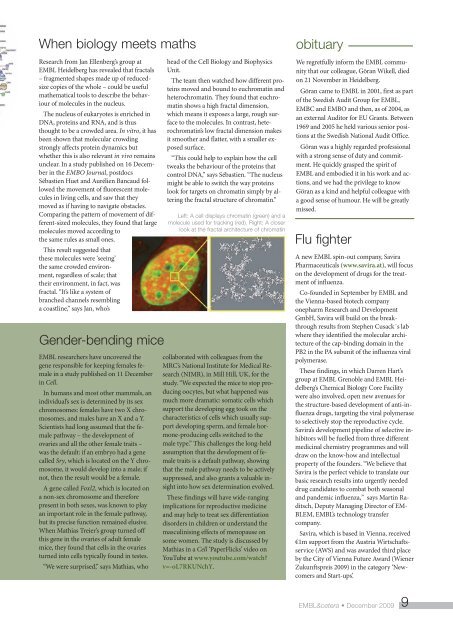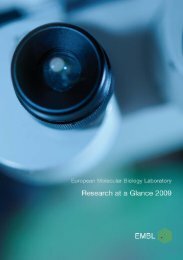Bernd-Uwe retires - EMBL Grenoble
Bernd-Uwe retires - EMBL Grenoble
Bernd-Uwe retires - EMBL Grenoble
Create successful ePaper yourself
Turn your PDF publications into a flip-book with our unique Google optimized e-Paper software.
When biology meets mathsResearch from Jan Ellenberg’s group at<strong>EMBL</strong> Heidelberg has revealed that fractals– fragmented shapes made up of reducedsizecopies of the whole – could be usefulmathematical tools to describe the behaviourof molecules in the nucleus.The nucleus of eukaryotes is enriched inDNA, proteins and RNA, and is thusthought to be a crowded area. In vitro, it hasbeen shown that molecular crowdingstrongly affects protein dynamics butwhether this is also relevant in vivo remainsunclear. In a study published on 16 Decemberin the EMBO Journal, postdocsSébastien Huet and Aurélien Bancaud followedthe movement of fluorescent moleculesin living cells, and saw that theymoved as if having to navigate obstacles.Comparing the pattern of movement of different-sizedmolecules, they found that largemolecules moved according tothe same rules as small ones.This result suggested thatthese molecules were ‘seeing’the same crowded environment,regardless of scale; thattheir environment, in fact, wasfractal. “It’s like a system ofbranched channels resemblinga coastline,” says Jan, who’sGender-bending mice<strong>EMBL</strong> researchers have uncovered thegene responsible for keeping females femalein a study published on 11 Decemberin Cell.In humans and most other mammals, anindividual’s sex is determined by its sexchromosomes: females have two X chromosomes,and males have an X and a Y.Scientists had long assumed that the femalepathway – the development ofovaries and all the other female traits –was the default: if an embryo had a genecalled Sry, which is located on the Y chromosome,it would develop into a male; ifnot, then the result would be a female.A gene called Foxl2, which is located ona non-sex chromosome and thereforepresent in both sexes, was known to playan important role in the female pathway,but its precise function remained elusive.When Mathias Treier’s group turned offthis gene in the ovaries of adult femalemice, they found that cells in the ovariesturned into cells typically found in testes.“We were surprised,” says Mathias, whohead of the Cell Biology and BiophysicsUnit.The team then watched how different proteinsmoved and bound to euchromatin andheterochromatin. They found that euchromatinshows a high fractal dimension,which means it exposes a large, rough surfaceto the molecules. In contrast, heterochromatin’slow fractal dimension makesit smoother and flatter, with a smaller exposedsurface.“This could help to explain how the celltweaks the behaviour of the proteins thatcontrol DNA,” says Sébastien. “The nucleusmight be able to switch the way proteinslook for targets on chromatin simply by alteringthe fractal structure of chromatin.”Left: A cell displays chromatin (green) and amolecule used for tracking (red). Right: A closerlook at the fractal architecture of chromatincollaborated with colleagues from theMRC’s National Institute for Medical Research(NIMR), in Mill Hill, UK, for thestudy. “We expected the mice to stop producingoocytes, but what happened wasmuch more dramatic: somatic cells whichsupport the developing egg took on thecharacteristics of cells which usually supportdeveloping sperm, and female hormone-producingcells switched to themale type.” This challenges the long-heldassumption that the development of femaletraits is a default pathway, showingthat the male pathway needs to be activelysuppressed, and also grants a valuable insightinto how sex determination evolved.These findings will have wide-rangingimplications for reproductive medicineand may help to treat sex differentiationdisorders in children or understand themasculinising effects of menopause onsome women. The study is discussed byMathias in a Cell ‘PaperFlicks’ video onYouTube at www.youtube.com/watch?v=-oL7RKUNchY.obituaryWe regretfully inform the <strong>EMBL</strong> communitythat our colleague, Göran Wikell, diedon 21 November in Heidelberg.Göran came to <strong>EMBL</strong> in 2001, first as partof the Swedish Audit Group for <strong>EMBL</strong>,EMBC and EMBO and then, as of 2004, asan external Auditor for EU Grants. Between1969 and 2005 he held various senior positionsat the Swedish National Audit Office.Göran was a highly regarded professionalwith a strong sense of duty and commitment.He quickly grasped the spirit of<strong>EMBL</strong> and embodied it in his work and actions,and we had the privilege to knowGöran as a kind and helpful colleague witha good sense of humour. He will be greatlymissed.Flu fighterA new <strong>EMBL</strong> spin-out company, SaviraPharmaceuticals (www.savira.at), will focuson the development of drugs for the treatmentof influenza.Co-founded in September by <strong>EMBL</strong> andthe Vienna-based biotech companyonepharm Research and DevelopmentGmbH, Savira will build on the breakthroughresults from Stephen Cusack´s labwhere they identified the molecular architectureof the cap-binding domain in thePB2 in the PA subunit of the influenza viralpolymerase.These findings, in which Darren Hart’sgroup at <strong>EMBL</strong> <strong>Grenoble</strong> and <strong>EMBL</strong> Heidelberg’sChemical Biology Core Facilitywere also involved, open new avenues forthe structure-based development of anti-influenzadrugs, targeting the viral polymeraseto selectively stop the reproductive cycle.Savira’s development pipeline of selective inhibitorswill be fuelled from three differentmedicinal chemistry programmes and willdraw on the know-how and intellectualproperty of the founders. “We believe thatSavira is the perfect vehicle to translate ourbasic research results into urgently neededdrug candidates to combat both seasonaland pandemic influenza,” says Martin Raditsch,Deputy Managing Director of EM-BLEM, <strong>EMBL</strong>’s technology transfercompany.Savira, which is based in Vienna, received€1m support from the Austria Wirtschaftsservice(AWS) and was awarded third placeby the City of Vienna Future Award (WienerZukunftspreis 2009) in the category ‘Newcomersand Start-ups’.<strong>EMBL</strong>&cetera • December 20099













